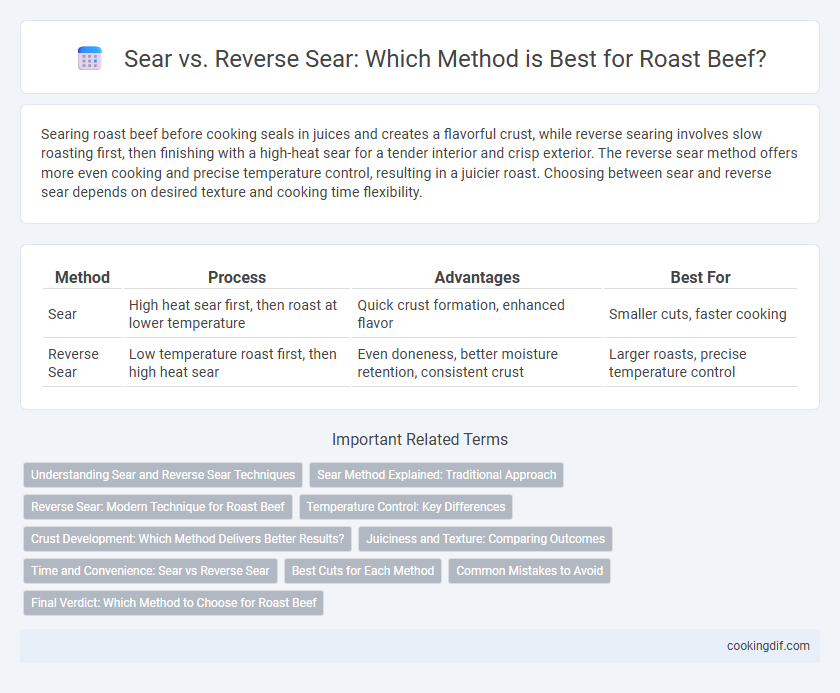Searing roast beef before cooking seals in juices and creates a flavorful crust, while reverse searing involves slow roasting first, then finishing with a high-heat sear for a tender interior and crisp exterior. The reverse sear method offers more even cooking and precise temperature control, resulting in a juicier roast. Choosing between sear and reverse sear depends on desired texture and cooking time flexibility.
Table of Comparison
| Method | Process | Advantages | Best For |
|---|---|---|---|
| Sear | High heat sear first, then roast at lower temperature | Quick crust formation, enhanced flavor | Smaller cuts, faster cooking |
| Reverse Sear | Low temperature roast first, then high heat sear | Even doneness, better moisture retention, consistent crust | Larger roasts, precise temperature control |
Understanding Sear and Reverse Sear Techniques
Searing involves cooking roast beef at high heat initially to develop a flavorful crust through the Maillard reaction, locking in juices and enhancing texture. The reverse sear technique starts with slow, low-temperature cooking to ensure even doneness throughout the roast, followed by a final high-heat sear to create a caramelized exterior. Understanding these methods helps optimize flavor and tenderness while controlling internal temperature precision for perfect roast beef.
Sear Method Explained: Traditional Approach
The traditional sear method for roast beef involves cooking the meat at a high temperature initially to create a flavorful, caramelized crust that locks in juices. This approach typically starts by preheating a pan or oven to around 450degF (232degC) before placing the roast directly in to brown the exterior. By sealing the surface quickly, the sear method enhances Maillard reactions, resulting in rich, savory flavors and an appealing texture.
Reverse Sear: Modern Technique for Roast Beef
Reverse sear is a modern technique for roast beef that involves slow-cooking the meat at a low temperature until it reaches the desired internal temperature, followed by a high-heat sear to create a flavorful crust. This method ensures even cooking throughout the roast and enhances juiciness and tenderness by reducing overcooking at the edges. The precise temperature control and gradual cooking process make reverse searing ideal for achieving consistent, restaurant-quality roast beef results.
Temperature Control: Key Differences
Searing roast beef at high heat first creates a flavorful crust but risks overcooking the interior due to limited temperature control. Reverse searing involves slow roasting at a low temperature before searing, allowing precise internal temperature regulation and even cooking. This method achieves a consistent doneness edge-to-edge with a perfectly caramelized exterior.
Crust Development: Which Method Delivers Better Results?
Reverse sear creates a more evenly developed crust on roast beef by slowly bringing the meat to temperature before finishing with high heat, enhancing Maillard reaction and deep flavor layers. In contrast, searing first can result in a less uniform crust, with a risk of overcooking the outer layer while aiming for the desired internal doneness. For optimal crust development and juicy interior, many chefs prefer reverse sear due to its controlled, gradual cooking process.
Juiciness and Texture: Comparing Outcomes
Sear roasting creates a flavorful crust by cooking roast beef at high heat initially, which can sometimes cause moisture loss and a less uniform texture. Reverse searing involves slow roasting at low temperatures before finishing with a high-heat sear, resulting in enhanced juiciness and a consistent, tender interior. The reverse sear method typically produces more even cooking and improved texture by minimizing overcooked edges and retaining natural meat juices.
Time and Convenience: Sear vs Reverse Sear
Searing roast beef first creates a flavorful crust quickly but can result in uneven cooking and longer overall time due to resting. Reverse searing involves slow roasting at low temperatures before a final high-heat sear, offering more even doneness and shorter active cooking time. This method is generally more convenient for precise temperature control and less hands-on monitoring.
Best Cuts for Each Method
Tender cuts like ribeye and sirloin excel with traditional searing, locking in juices quickly before roasting. Reverse sear suits thicker, tougher cuts such as brisket or chuck roast, as slow cooking first tenderizes the meat evenly. Choosing the right cut maximizes flavor and texture when applying either sear or reverse sear methods for roast beef.
Common Mistakes to Avoid
Overcooking the outer layer is a common mistake with the sear method, causing dryness and toughness in roast beef. In reverse sear, failing to properly monitor internal temperature during the slow roast can result in uneven doneness or overcooked edges. Avoid skipping resting time after both methods, as it allows juices to redistribute, ensuring a tender and flavorful roast.
Final Verdict: Which Method to Choose for Roast Beef
Sear provides a robust, caramelized crust by cooking roast beef at high heat first, locking in juices and flavor, while reverse sear uses low-temperature roasting followed by a quick high-heat sear to ensure even cooking and a tender interior. For optimal roast beef results, the reverse sear method offers superior control over doneness and juiciness, producing a consistent medium-rare center with a perfectly browned exterior. Choose reverse sear when precision and tenderness are priorities, and sear-first when a deeply flavorful crust is preferred.
Sear vs Reverse Sear for roast beef Infographic

 cookingdif.com
cookingdif.com